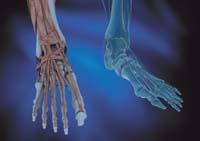Walking on foot, more effective than on four legs
2007/09/02 Galarraga Aiestaran, Ana - Elhuyar Zientzia

(Photo: Minnesota Science Museum)
In fact, chimpanzees usually circulate on four legs, or rather supported on the feet and knuckles. However, they can circulate on two legs when they carry something or when they are picking up food. The man, for his part, moves on two legs since he is able to do so, approximately since he turns one year, which differentiates the man from his ancestors (hominids) from the rest of primates.
Energy expenditure measurement
In a 1973 investigation, no major differences were observed in energy expenditure, as the primate moved four or two legs. However, only young primates participated in this experiment, so the conclusions are not correct.

They have now conducted an experiment in which five chimpanzees participated. They have trained to walk on a tape, on the usual route, that is, on four legs, and also on two legs. Then they make them walk on the tape in two ways, with special masks to know how much they consume oxygen. The results obtained were compared to those provided by four people during the same exercise.
Thus, they have shown that, considering the weight of each, people use four times less energy when walking than chimpanzees. In addition, they have seen that chimpanzees have a similar average expenditure, both on gatear and on two legs. One of the chimpanzees, however, is out of the average, that is, it travels long steps and its march is more effective in two legs than in four legs. As for the energy people spend when walking, there are no big differences between volunteers.
Walking on foot, more effective

Compared to chimpanzees, scientists wanted to know why there is so much difference in efficiency. Researchers believe that by walking more or less energy they spend depending on the length of the step and the muscles they use
According to the laws of biomechanics, energy consumption increases if short steps are taken and if large muscle mass is used. Therefore, the long-legged chimpanzee spends less energy than the rest when walking on two legs. On the other hand, man has long straight legs, and the pelvis is also different from the other primates. This allows the two factors that influence energy consumption to be smaller than chimpanzees.
Researchers have also analyzed the fossils of the first hominids in this regard. In particular, they have checked whether these hominids had any characteristic that helps reduce the energy expenditure of walking on two legs. And, apparently, the first hominids had characteristics suitable for a low energy use when walking on two legs.
In addition, researchers believe that if, as in chimpanzees today, hominids needed much less energy than others to walk, natural selection would support the former. So, in short, people walk up because we spend less energy on two legs than on four, according to the University of Washington study.
Published in 7K.

Gai honi buruzko eduki gehiago
Elhuyarrek garatutako teknologia





